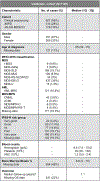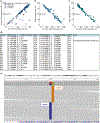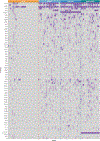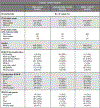Implications of TP53 allelic state for genome stability, clinical presentation and outcomes in myelodysplastic syndromes
- PMID: 32747829
- PMCID: PMC8381722
- DOI: 10.1038/s41591-020-1008-z
Implications of TP53 allelic state for genome stability, clinical presentation and outcomes in myelodysplastic syndromes
Erratum in
-
Author Correction: Implications of TP53 allelic state for genome stability, clinical presentation and outcomes in myelodysplastic syndromes.Nat Med. 2021 Mar;27(3):562. doi: 10.1038/s41591-021-01253-5. Nat Med. 2021. PMID: 33564192 No abstract available.
-
Author Correction: Implications of TP53 allelic state for genome stability, clinical presentation and outcomes in myelodysplastic syndromes.Nat Med. 2021 May;27(5):927. doi: 10.1038/s41591-021-01367-w. Nat Med. 2021. PMID: 33948021 No abstract available.
Abstract
Tumor protein p53 (TP53) is the most frequently mutated gene in cancer1,2. In patients with myelodysplastic syndromes (MDS), TP53 mutations are associated with high-risk disease3,4, rapid transformation to acute myeloid leukemia (AML)5, resistance to conventional therapies6-8 and dismal outcomes9. Consistent with the tumor-suppressive role of TP53, patients harbor both mono- and biallelic mutations10. However, the biological and clinical implications of TP53 allelic state have not been fully investigated in MDS or any other cancer type. We analyzed 3,324 patients with MDS for TP53 mutations and allelic imbalances and delineated two subsets of patients with distinct phenotypes and outcomes. One-third of TP53-mutated patients had monoallelic mutations whereas two-thirds had multiple hits (multi-hit) consistent with biallelic targeting. Established associations with complex karyotype, few co-occurring mutations, high-risk presentation and poor outcomes were specific to multi-hit patients only. TP53 multi-hit state predicted risk of death and leukemic transformation independently of the Revised International Prognostic Scoring System (IPSS-R)11. Surprisingly, monoallelic patients did not differ from TP53 wild-type patients in outcomes and response to therapy. This study shows that consideration of TP53 allelic state is critical for diagnostic and prognostic precision in MDS as well as in future correlative studies of treatment response.
Conflict of interest statement
Competing interests
The authors declare the following competing interests.
Figures














Comment in
-
Context Determines Effects of TP53 Mutations.Cancer Discov. 2020 Nov;10(11):1616. doi: 10.1158/2159-8290.CD-NB2020-088. Epub 2020 Sep 25. Cancer Discov. 2020. PMID: 32978231
References
Publication types
MeSH terms
Substances
Grants and funding
LinkOut - more resources
Full Text Sources
Medical
Research Materials
Miscellaneous

